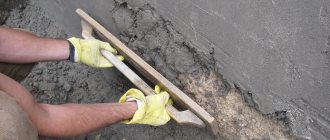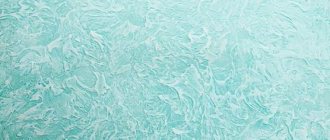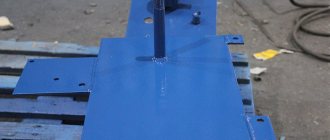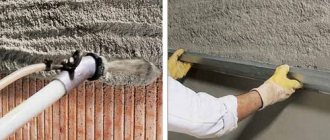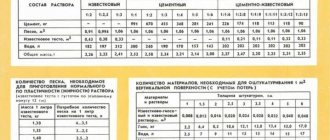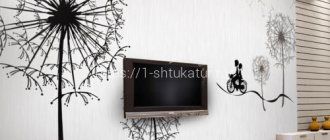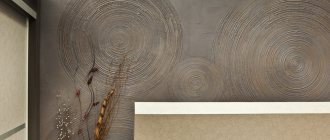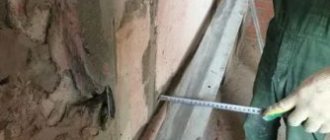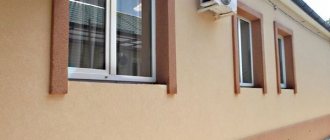Areas of application of cement plaster
Cement mortar adheres well to brick and concrete, filling even small potholes. The coating is quite smooth, without cracks or large defects.
Cement-based plaster is used for the following work:
- facade finishing;
- plastering and leveling surfaces in rooms without heating (balconies, loggias) or rooms with high humidity (bathrooms);
- sealing seams and cracks of external and internal walls;
- leveling surfaces with large defects and large dips;
- preparing walls for tiles.
By the way, in damp rooms mold or mildew may appear on unfinished cement plaster. In this case, the walls are etched with a neutralizing solution.
For stone and wooden surfaces it is better to use cement-lime mixtures. Ordinary sand-cement ones will not stick to them well.
Advantages and disadvantages
The main advantages of cement compositions include:
- increased durability of the coating: unlike gypsum, it is not so easy to chip or crumble such plaster;
- resistance to temperature and humidity fluctuations;
- durability: even when finishing facades that are most exposed to adverse weather conditions, waterproof cement-sand plaster can last up to 15 years or more without repair;
- high adhesion to most types of surfaces, including concrete, brick, cinder block, stone;
- ease of making the solution: it can be prepared even at home by simply mixing cement with sand and water in the required proportions;
- affordable price: ready-made DSP plasters are 15-20% cheaper than gypsum plasters, and if you mix it yourself, the price will be 2-3.5 times lower.
But cement-based coatings also have a number of disadvantages:
- it is difficult to work with heavy viscous mortar and level it;
- the surface turns out to be rough, so it requires applying an additional finishing layer of gypsum if you plan to paint the wall or wallpaper;
- cement-sand mortar makes the walls heavier, so the load on the foundation will also increase;
- poor adhesion to painted and wooden surfaces;
- It is not recommended to apply cement plaster to plaster - a heavy layer will simply tear it off;
- it shrinks, so if you apply too thin a layer it can crack; The minimum layer is 5 mm, the maximum is 30 mm. If a thicker leveling coating is required, it is applied with mesh reinforcement, plastering 2-3 times, drying each layer.
Composition of cement-sand mortar
The composition of an ordinary cement-sand mortar includes water, sand and a binder - cement, mixed in a certain proportion . The strength of such a coating directly depends on the brand of cement used. Cement M150-200 is used only for interior work, and the more durable grade M300 and higher is used for plastering facades.
Maintaining proportion is very important. If there is not enough sand, the mixture will dry quickly and be less durable after drying. You can use cement without sand only for filling small cracks; this composition is not suitable for leveling coatings.
Using sand that is too fine is also undesirable, because such plaster may crack. The presence of large amounts of impurities in the sand, for example, clay and soil fragments, can lead to weakening of the finish and its cracking.
The quality of the surface also depends on the type of sand used. The ideal option is river or washed quarry sand with a fraction size of 0.5-2 mm. The presence of large grains of sand will make the surface excessively rough. Sand with a grain size of 2.5 mm is used only for brickwork, and coarser sand, up to 5 mm, is used for the installation of reinforced concrete structures.
In addition to the usual CPS, there is light cement plaster, which contains lime and mineral fillers. Due to its porous structure, it has lower thermal conductivity.
To impart plasticity to the solution and increase adhesion to the surface, various plasticizers are added to it. Usually their share in the solution does not exceed 1%. Lime paste also improves the properties of cement.
4 Technical requirements
4.1 Decorative plaster compositions must comply with the requirements of this standard and be manufactured according to technological documentation approved by the manufacturer.
4.2 The properties of decorative plaster compositions should be characterized by indicators of their quality in a dry state, the quality of mortar and hardened compositions.
4.2.1 The main indicators of the quality of decorative plaster compositions in a dry state are: - humidity; — the largest grain size of the filler; — content of grains of the largest size (according to the manufacturer’s technological documentation); - bulk density.
4.2.2 The main indicators of the quality of decorative plaster mortar compositions are: - mobility; — preservation of initial mobility; — water-holding capacity; — resistance to the formation of shrinkage cracks; — density.
4.2.3 The main indicators of the quality of hardened decorative plaster compositions at the design age are: - compressive strength; — tensile strength in bending; — adhesion strength (adhesion) to the concrete base; — frost resistance; — vapor permeability; - water absorption; — shrinkage deformation; - average density (at the request of the consumer and if necessary); - flammability group. If necessary, additional indicators can be established in accordance with GOST 4.233 or the terms of the contract.
4.3 The symbol of the compositions must consist of a name in accordance with GOST 33740, scope of application, information about tinting, designations of the class of compressive strength, class of tensile strength in bending, class of adhesion strength to the base, brand of frost resistance, symbol of the specific manufacturer and designation of this standard. An example of a symbol for a decorative composition on white Portland cement, unpainted, intended for SFTK, compressive strength class B3.5, tensile strength class in bending 0.8, adhesion strength class 1 to the base, frost resistance grade F50: Decorative composition on white Portland cement for facade thermal insulation composite systems with external plaster layers, unpainted B3.5,
0.8 , 1, F50,
GOST 33740-2016 It is allowed to enter additional data into the symbol for complete identification of the composition.
4.4 Requirements for decorative plaster compositions in dry condition
4.4.1 The moisture content of the compositions should not exceed 0.30% by weight.
4.4.2 The largest grain size of aggregate in decorative plaster compositions should not exceed 5 mm.
4.4.3 The bulk density of the compositions must be no less than 1200 kg/m and no more than 1800 kg/m.
4.5 Requirements for decorative plaster mortars
4.5.1 The mobility of mortar compositions, determined by the immersion of the cone, must correspond to the brand (immersion depth of the cone 8-12 cm).
4.5.2 The persistence of the initial mobility of mortar compositions is determined by the retention time of the initial mobility, min. The retention of the initial mobility of the compositions must be no less than the period of time during which they are produced according to the manufacturer’s information.
4.5.3 The water-holding capacity of mortar compositions must be at least 95%.
4.5.4 Decorative plaster mortar compositions must be resistant to cracking. The formation of cracks on the surface of the hardening composition is not allowed.
4.5.5 The density of mortar compositions must be no less than 1200 kg/m and no more than 1800 kg/m.
4.6 Requirements for hardened compounds
4.6.1 Standardized quality indicators of hardened compositions must be ensured at the design age (28 days) subject to the conditions of natural hardening at a constant temperature (21±3)°C and relative air humidity (55±10)%.
4.6.2 Depending on the compressive strength, classes (grades) of hardened decorative plaster compositions at design age are established, given in Table 1. Table 1 - Classes (grades) of hardened compositions by compressive strength
| Class (brand) | B2.5 (M35) | B3.5 (M50) | B5 (M75) | B7.5 (M100) |
| Compressive strength, MPa, not less | 3,3 | 4,5 | 6,5 | 10,0 |
4.6.3 Depending on the tensile strength in bending at the design age, classes of hardened decorative plaster compositions are established (see Table 2). Table 2 - Classes of hardened compositions according to tensile strength in bending
| Class | 0,8 | 1,6 | 2,4 | 3,2 |
| Tensile strength in bending, MPa, not less | 1 | 2 | 3 | 4 |
4.6.4 Depending on the strength of adhesion to the concrete base (adhesion) at the design age, the classes of hardened decorative plaster compositions given in Table 3 are established. Table 3 - Classes of hardened compositions by adhesion strength (adhesion)
| Class | 0,5 | 1 | 2 | 3 |
| Strength of adhesion to the base (adhesion), MPa, not less | 0,25 | 0,35 | 0,5 | 0,65 |
Note - Concrete slabs in accordance with GOST 31356 must be used as a concrete base for testing when determining adhesion to the base. The nature of the separation of samples must correspond to types AT-2 and AT-3 in accordance with GOST 31356.
4.6.5 Decorative plaster compositions must have a frost resistance grade of at least F50.
4.6.6 Water absorption of hardened compositions when saturated with water and when samples are completely immersed in water should not exceed 15% by weight.
4.6.7 The shrinkage deformation of hardened decorative plaster compositions should be no more than 2.0 mm/m (or 0.2%). Expansion deformation is not allowed.
4.6.8 The vapor permeability resistance of hardened decorative plaster compositions should be no more than 0.15 m h Pa/mg. Note - The vapor permeability of hardened decorative plaster compositions must be at least 0.035 mg/m·h·Pa.
4.6.9 The specific effective activity of natural radionuclides of decorative plaster compositions should not exceed the limit values established by GOST 30108.
4.6.10 The flammability group of hardened compositions must be not lower than NG.
4.7 Requirements for materials for the manufacture of decorative plaster compositions
4.7.1 Cementing materials used for the manufacture of compositions must comply with the requirements of regulatory or technical documents for these materials, as well as the requirements of this standard.
4.7.2 The following binders are used: - Portland cement in accordance with GOST 10178 or GOST 31108; — white cement according to GOST 965; - mixed (complex) binders according to regulatory or technical documents for specific types of binders.
4.7.3 The alkali content in cement binders intended for the manufacture of decorative plaster compositions should not exceed 0.6% by weight. Lime in mixed (complex) binders should not contain unslaked lime particles.
4.7.4 Fillers, fillers and additives used for the manufacture of decorative plaster compositions must comply with the requirements of regulatory or technical documents for these materials and ensure that the compositions are obtained in accordance with the requirements of this standard.
4.7.5 The following are used as aggregates and fillers: - sand for construction work in accordance with GOST 8736; — decorative sand according to GOST 22856; — quartz sand and ground sandstone according to GOST 22551; — expanded perlite sand in accordance with GOST 10832. It is allowed to use other types of aggregates and fillers (quartz or marble chips or flour, etc.), ensuring the manufacture of compositions in accordance with the requirements of this standard.
4.7.6 The specific effective activity of natural radionuclides of materials used for the manufacture of decorative plaster compositions must not exceed the limit values established by GOST 30108.
4.7.7 Chemical additives in terms of effectiveness must meet the effectiveness criteria in accordance with GOST 30459. Chemical additives are introduced into the compositions during their production in the form of water-soluble powder and/or granules.
4.8 Packaging and labeling
4.8.1 The compositions are packaged in multilayer paper bags made of kraft paper with special hydrophobic impregnation or with a polyethylene liner, as well as in special types of packaging with a capacity of more than 50 kg (big bags). The mass of the compositions in bags should not exceed 50 kg, in big bags - 1 ton. The permissible deviation in the mass of the dry mixture in one packaging unit is in accordance with GOST 8.579. The packaging must protect the composition from moisture. Violation of the integrity of the packaging is not allowed.
4.8.2 Marking is applied to each unit of packaging in any part of it. The marking must be clear and contain: - the name of the manufacturer and/or its trademark, address; — symbol of the composition; — date of manufacture (month, year); — batch number; - warranty period of storage; — mass of the composition in a packaging unit, kg; — brief instructions for use indicating the volume of water required to prepare the solution composition, l/kg or liter per package. If necessary, the marking may contain additional data to more fully identify the product.
4.8.3 Transport marking - in accordance with GOST 14192 with the application of the handling sign “Keep away from moisture”.
Specifications
Density. The strength and thermal conductivity of the plaster mixture directly depend on its density. Cement-sand mortars in their pure form, without additives, are classified as heavy and have a density in the hardened state of 1600-1800 kg/m3. This is a fairly durable coating that is used not only for facade or interior decoration, but also as a floor screed.
Thermal conductivity . Due to its high density, the thermal conductivity of cement-sand screed is high. Unlike the more porous gypsum, which stores heat well and has a thermal conductivity coefficient of 0.3 W (m*K), the thermal conductivity of plaster based on cement and sand is 0.9 W (m*K).
Vapor permeability . To avoid the formation of condensation in the room, the walls must absorb excess moisture and remove it outside. Therefore, when choosing a material for wall decoration, such an indicator as vapor permeability is also taken into account. For gypsum and cement mortars it is approximately the same and is equal to 0.11-0.14 in the first case, and 0.09 mg/mhPa in the second.
Drying time . At a temperature of +15-25°C, a layer 2 cm thick will dry in 12-14 hours. As its thickness increases, the drying time naturally increases, so to be sure, it is better not to touch the plastered surface for a day.
This article provides a comparative review of cement-sand and gypsum plaster. It also talks about a mixture of cement and gypsum.
For clarity, we summarize all the characteristics in one table.
How to choose plaster
Introduction
When choosing a dry building mixture for performing plastering finishing work, you must be guided by the current set of rules (SP) and state standards of the Russian Federation (GOST, GOST R). At the same time, it is necessary to take into account the climatic zone of the location of the construction project, the type of building foundation to be finished, its existing technical condition, functional features and subsequent operating conditions of the facility, the estimated operating life and service life of the facility, including the layer of plaster finishing that is being installed. And also, the required time frame for completing the finishing work, the intended method of applying the material, the quality of the final surface and the type of finishing coating established by the work execution project (WPP).
As a rule, materials manufactured in the Russian Federation and intended for plastering finishing work must comply with the state standards in force in the Russian Federation (GOST, GOST R), which establish requirements for the properties and characteristics of materials.
Based on the individual properties and characteristics of materials, the current set of rules (SP) establishes the scope of application of each type of material. And also, the method of its use and application technology.
Current codes of practice and State standards
The current set of rules and state standards of the Russian Federation, establishing general rules for performing finishing work, requirements for the properties and characteristics of the materials used for performing plastering and finishing work:
— SP 71.13330.2017
: establishes the rules for the production and acceptance of insulation and finishing work when installing insulating layers of roofs, insulating coatings of equipment and pipelines, interiors of buildings and structures, including protective coatings and floor coverings.
— GOST 31189-2015:
applies to dry building mixtures used in the construction, reconstruction and repair of buildings and structures, and establishes their classification.
— GOST R 57984-2017:
establishes requirements and recommendations for the calculation, preparation, and execution of plaster for external work based on cement, lime or other mineral binders and/or combinations (mixtures) of them. Applies to plastering of new and old plaster substrates, as well as repair and strengthening of existing plaster.
— GOST R 57336-2016:
applies to factory-made plaster mortars made from inorganic binders used for application to load-bearing walls, ceilings, supports and dividing partitions during external and internal work. The standard contains definitions of terms and requirements for the technical characteristics of solutions. This standard applies to plaster mortars, the main binder of which is airborne lime. The standard does not apply to mortars whose main binder is gypsum.
— GOST 28013-98:
applies to mortars with mineral binders used for masonry and installation of building structures during the construction of buildings and structures, fastening facing products, plaster. The standard does not apply to special solutions (heat-resistant, chemical-resistant, fire-resistant, heat- and waterproofing, grouting, decorative, tensile, etc.).
— GOST R 58279-2018:
applies to dry building plaster mixtures of factory production, containing polymer additives of no more than 5% (in a dry state) by weight of the mixture, made with gypsum binders, mixed (complex) mineral binders based on gypsum binder, intended for interior work, leveling and plastering of concrete , stone, brick, gypsum and other surfaces when carrying out internal work during construction, repair and reconstruction of buildings and structures. This standard establishes technical requirements for dry mixes, mortar mixtures and hardened mortars.
— GOST 33083-2014:
applies to dry construction plaster mixtures made with a cement binder or mixed mineral binders based on Portland cement clinker, containing polymer additives in an amount not exceeding 5.0% of the mixture weight, intended for the installation of a finishing layer of mortar applied to the surface of buildings and structures for leveling it, preparing it for further finishing, as well as for protecting it from atmospheric influences or giving decorative properties. Plaster mixtures are used in the construction, reconstruction and repair of buildings and structures when carrying out external and internal work. This standard does not apply to plaster mixtures based on gypsum and lime binders.
Terms and Definitions
design (WPP)
: this is one of the main organizational and technological documents that describe the valid organizational and technological solutions used to ensure optimal manufacturability and safety of the relevant types of work, as well as the economic efficiency of capital investments. Establishes the procedure for engineering equipment and arrangement of the construction site, provides modeling of the construction process, forecasting possible risks, and determines the optimal construction time frame. Contains technological solutions and necessary organizational conditions for performing construction work.
Plaster (plaster mortar)
- a mixture of one or more binders, granular aggregates, water and, if necessary, additives and/or additional means, which is used as plaster.
Factory solution
- plaster, manufactured and mixed in a factory, as well as a dry mortar mixture, mixed and requiring the addition of water, and a wet mortar mixture, which is supplied ready for use.
Plaster system
- one or more layers of plaster applied to the base under the plaster in combination with a plaster mesh and/or reinforcement and/or pre-treatment.
Bottom layer of plaster
- the bottom layer or layers of the plaster system.
Top layer of plaster
- the topmost layer of a multi-layer plaster system.
Sanitizing plaster
- a solution tested for suitability for plastering moistened surfaces containing salts.
Reinforcement
- a material in the form of meshes introduced into the plaster layer to increase resistance to cracking.
Plaster mesh -
a flat rolled material in the form of a mesh, used to secure plaster to the base, as well as to increase the strength of the connection to the base and resistance to damage.
Dry mixtures for mechanized application -
dry mixtures with a complex of modifying (functional) additives that can be mixed, supplied to the application site and laid (applied) using specialized mechanical equipment.
Plaster heavy mixture
- a dry mixture, the solution of which has an average density of more than 1300 kg/m³.
Plaster light mixture
- a dry mixture, the solution of which has an average density of less than 1300 kg/m³.
Plaster thermal insulation mixture
- a dry mixture, the solution of which has an average density of less than 500 kg/m³.
Decorative plaster mixture (decorative plaster)
- a special industrially produced material intended for the installation of a decorative and protective finishing layer.
Work execution project (WPP)
The work design must include detail drawings and detailed requirements for the work. The detailing of the plastering project should be carried out taking into account the following criteria:
a) the quality and condition of the base for plaster;
b) requirements for environmental conditions when performing plastering;
c) reasonable requirements;
d) type of plaster;
e) surface type/appearance of plaster.
All construction participants must take into account the following requirements:
a) agreeing on deadlines for the required types of work with all participants;
b) suitability of atmospheric conditions during the application of plaster;
c) sufficient time for inspection and drying of the base for plaster;
d) sufficient time for preparing the base for plaster, applying and drying
(hardening) of each layer of plaster (including taking into account a possible increase in time);
e) updating the work plan at all stages;
f) sufficient time to control the work in accordance with the work plan.
Data on the completion of work at individual construction sites is recorded and stored in work production logs.
General classification of dry construction mixtures
Dry mixtures are classified according to: - conditions of use;
— largest grain size of filler Dz, max; - type of binder; — functional purpose; - method of application.
According to the conditions of use, dry mixtures are divided into those intended: - for external use; - for interior work.
According to the largest grain size of the filler Dz, max, dry mixtures are divided into: a) mortar with grains less than 5 mm in size: - coarse-grained (0 mm < Dz, max < 5 mm), - fine-grained (0 mm < Dz, max < 1.25 mm), - finely dispersed (0 mm <D z, max <0.2 mm); b) concrete with grains larger than 5 mm.
Based on the type of binder used, dry mixtures are divided into: - cement
;
- gypsum
;
- limestone
;
- magnesium; - polymer; - mixed
.
According to their functional purpose, dry mixtures are divided: a) into masonry: - thick-layer (layer thickness more than 5 mm), - thin-layer (layer thickness up to 5 mm);
b) for plastering
: - heavy (with an average density of more than 1300 kg/m³), - light (with an average density of less than 1300 kg/m³), - especially heavy (with an average density of more than 2300 kg/m³);
c) for putty: - leveling, - finishing;
d) for adhesive materials intended for laying: - facing materials (cladding tiles), - sheet materials (plasterboard sheets, etc.);
e) for grouting (seam): - for narrow joints (up to 6 mm inclusive), - for wide joints (more than 6 mm);
f) for floors: - according to the intended purpose for the device: 1) screeds, 2) leveling layers (interlayers), 3) finishing coatings; — by installation method: 1) leveled, 2) self-leveled;
g) for repair: - surface restoration
, - volumetric-restorative structural, - injection;
i) for insulation: - waterproofing
: 1) superficial, 2) injection, 3) penetrating;
— heat and sound insulation
: 1) heat insulation (average density less than 500 kg/m³), 2) heat insulation and structural (average density more than 500 kg/m³), 3) sound insulation;
j) for special ones: - protective
: 1) fire-retardant, 2) fire-resistant and heat-resistant, 3) inhibitory, 4) corrosion-protective, 5) radiation-protective, 6) biocidal;
— restoration, ensuring
: 1) compliance with the mechanical properties of the object being restored, 2) authenticity of the composition of the mixture, 3) compliance with the appearance of the object being restored;
— sanitizing for the device
: 1) base adhesion layer, 2) leveling moisture- and salt-accumulating layer, 3) finishing vapor-permeable layer;
l) for facade thermal insulation composite systems with external plaster layers for the installation of: - adhesive layer, - reinforced base plaster layer, - leveling layer, - decorative and protective finishing layer
.
According to the method of application, dry mixtures are divided into: - mixtures of mechanized application
;
- hand-applied mixtures
.
Reliability and durability of plastering materials and systems
The reliability of finishing plaster layers and systems can be ensured through proper design and selection of materials. When selecting, it is necessary to take into account the following factors and criteria that affect the durability of the plaster:
- Purpose and scope;
— resistance to damage due to abrasion and impact;
— probable formation of corrosion of metallic inclusions;
— presence and calculation of expansion joints;
— compatibility of the plaster with the base for plaster and sufficient adhesion strength;
— deformation of mating elements or parts of the building;
- formation of cracks and hairline cracks;
— wetting from rainwater and moisture accumulation;
— probable formation of efflorescence;
— degree of environmental aggressiveness and frost resistance.
Also, the durability of the plaster depends on the type of base for the plaster, the type and composition of the plaster, and the method of its application.
Selecting the type and composition of plaster mortar
The selection of the type of plaster systems is carried out and depends on:
- expected appearance;
— operating conditions;
- type of base for plaster;
— requirements for the decorative and protective properties of plaster, taking into account the totality of the given criteria.
Types of plaster mortars and mixtures are selected taking into account their compatibility with the properties of the base for plaster, especially in terms of strength and deformation characteristics.
Also, it is necessary to take into account the compatibility of the properties of the plaster layers.
The plaster system consists of at least two layers: a lower (base) layer of plaster, and an upper (decorative and protective) layer of plaster. With the exception of single-layer plaster systems.
Gypsum-based products soften when exposed to moisture for a long time. The use of products of this type in the outdoor area depends on the climatic conditions in which the plaster is used and on local requirements in construction. Gypsum plasters are not recommended for external use and are not the subject of this standard.
Their use may be permitted and controlled by regulations in force at the regional level.
Recommendations for the thickness of plaster systems
For special application conditions, for example stucco elements where the thickness of the plaster is more than 35 mm, auxiliary elements of mechanical fastening should be used when installing the plaster layer.
Spray plaster and decorative plaster are not counted as a layer of plaster and in the total thickness of the plaster.
The thickness of plaster for special purposes, for example, fire-resistant, thermal insulation, sound insulation, increased radiation absorption, must ensure that the requirements for the corresponding special application are met.
Polymer-modified cement plasters should be applied with a layer thickness of 2 to 8 mm, and in accordance with the requirements of the manufacturer's technical documentation.
Thermal insulating plasters are part of the system, for example with a suitable top layer of plaster. They are applied in thicker layers than standard plasters. The thermal insulating base layer of plaster should have a thickness of 20 to 100 mm, and can be applied in one or more layers. The average thickness of the top layer of heat-insulating plaster, consisting of one or two layers, should be 10 mm (from 8 to 15 mm) unless the manufacturer requires a smaller layer thickness. For top layers of plaster consisting of several layers, the leveling plaster layer must have a minimum thickness of 6 mm, unless otherwise specified by the manufacturer.
Sanitation plasters can be applied as lower layers of plaster, with a minimum thickness of 15 mm, and each subsequent layer with a minimum thickness of 10 mm.
For external work, non-flammable plasters (NG, KM0) should be used. Plaster is taken into account when assessing the fire resistance of wall structures as a whole, but in itself is not a fire resistance characteristic.
Standard mortar, and most other plaster mortars, due to their high thermal conductivity and the implementation of a thin layer, slightly increase the thermal properties of walls without thermal insulation. However, plaster can prevent the lightweight substrate from becoming wet and maintain thermal insulation properties.
There are thermal insulating plasters and plastering systems that have a thermal conductivity of ≤0.2 W/(m K) designed to improve the thermal insulation of walls. These plasters are part of special proprietary factory-made mortar systems and are made with thicker layers than standard mortars.
When using heat-insulating plasters in a project, it is necessary to eliminate or reduce the influence of cold bridges on the thermal properties of structures.
| Type of building base | Number of layers in the plaster system | Minimum total thickness of plaster | General nominal plaster thickness |
| Concrete and reinforced concrete | 2 mm | 15 mm | (B) |
| Capital masonry | 2 mm 3 mm | 15 mm 20 mm | (B) |
| Double layer masonry | 2 mm 3 mm | 15 mm 20 mm | (B) |
| Using plaster mesh (c) | 3 mm | 20 mm | (B) |
| The minimum total thickness of the plaster depends on the shape and evenness of the base for the plaster. (B) - the thickness must be greater than the minimum thickness to compensate for unevenness in the quality of the plaster base, surface structure, etc. (c) - the thickness of the plaster is indicated from the outer surface of the plaster mesh. | |||
Recommendations for the thickness of single-layer plasters
| Type of building base | (General) minimum thickness of plaster layer | |
| Before mashing | Without mashing or after mashing | |
| Concrete and reinforced concrete | 10 mm | 6 mm |
| All types of building foundations, except concrete and reinforced concrete | according with manufacturer's instructions (B) | 15 (B) |
| (B) - factory-made water-repellent single-layer mortar must have an average thickness of 15 mm, and a minimum thickness of 10 mm unless otherwise recommended by the manufacturer | ||
Color and structure of plasters
The color of the dry mixture of plasters is determined by the content and quantity of cement, lime, fine granular aggregates and the water content in the mortar mixtures.
The color and shade of plaster solutions can change due to pigment additives included in the dry mixture of the material used.
Dark plaster surfaces, when exposed to direct sunlight, are more susceptible to temperature deformation than light ones.
The appearance of the final surface of the hardened plaster mortar is determined and achieved through technology and methods of processing the top layer of plaster, for example, by structuring or rubbing the surface.
Selection of materials for repair and restoration of plaster
on old and historical buildings
Before starting work on updating and eliminating defects in damaged plaster on old and historical buildings, built using materials and work methods different from those currently used, it is necessary to determine the reasons for the formation and volume of defects, assess the need for refurbishment, and also determine the operating conditions of the foundations and designs.
For buildings of historical significance, a historical report should be compiled based on the collection of information about the materials used during the construction of the building. When restoring the historical appearance of a building, it may be necessary to carry out measuring work and collect information from photographs or prints of decorative elements.
Restoration work should be calculated taking into account the influence of all the various factors determined from the results of the survey and environmental conditions.
When calculating, preparatory work and strengthening of structures should be taken into account.
When choosing plaster for restoration work, one should take into account the chemical and physical-mechanical properties of the plaster, the base for plaster, their compatibility, as well as the compatibility of plaster layers with each other.
When choosing materials for repair plastering work, you must:
- use mixtures similar in composition to the original;
— coordinate the use of modern materials with improved performance characteristics.
These principles should be taken into account when deciding on the need and possibility of preserving and restoring existing structures, the technical condition of which is unsatisfactory, there is high physical wear, or the construction of new structures that meet modern regulatory requirements.
Rehabilitation work begins with determining and clarifying the color, structure, design parameters, etc. in characteristic places in typical areas.
Drying and stabilization of wall structures can be carried out, if necessary, for several months or years before restoration of the plaster can be carried out. This period can be reduced by using porous (vapor-permeable) plasters.
Porous plasters
— plasters with an open porous structure, which may consist of desalting components, allow you to quickly dry the base for plaster.
It is allowed to use other types of plasters with capillary suction of moisture and permissible humidity values.
Special, ready-to-sell, factory-ready waterproof plasters for cladding
— made from cement, water-retaining additives, additives to improve adhesion and dry sand (fine fraction) to reduce shrinkage. Used in thin, waterproof layers with a thickness of 3 to 4 mm, or as a waterproof plaster with a thickness of 16 to 30 mm. Waterproof plasters must have sufficient vapor permeability to prevent moisture accumulation in the wall structure.
Hydrophobizing compounds
— water repellent formulas provide high levels of adhesive/cohesive adhesion. Such compositions penetrate into the thickness of the base under the plaster and impart long-term waterproof properties even at high hydrostatic water pressure. Penetration depth is 2-3 mm.
Lime plasters
— it is recommended to use slaked lime paste (slaking period is a year or more to improve properties) or powdered calcium hydroxide.
Local restoration and replacement of plaster
Modern materials used in the restoration of historical buildings should be selected from the point of view of the proximity of their physical and mechanical characteristics and operational properties to the characteristics of existing plaster.
Consumption of cement plaster per 1 m2
When calculating repair costs, you should pay attention to the consumption of plaster. Despite the fact that dry cement-sand mixtures are cheaper than gypsum mixtures, their consumption per 1 m2 is greater and amounts to 17 kg/m2 with a thickness of 10 mm. For example, gypsum per square meter with a thickness of 1 cm requires only 8-9 kg, that is, half as much. The manufacturer must indicate information about how much material is needed to create a layer of a certain thickness per 1 m2.
Let's calculate how much cement, sand and water will be needed to plaster 1 sq.m. The solution consumption rate is 17 kg/m2 (with a thickness of 10 mm). The amount of mixing water per 1 kg of dry mixture is 0.15 - 0.17 l. If for plaster we take a ratio of cement and sand of 1:4, then the mass of the necessary components will be equal to:
- Cement - 2.9 kg
- Sand - 11.7 kg
- Water - 2.4 kg
Cement-sand mixture for plaster: characteristics of the material.
The properties and required characteristics of cement-sand mixtures are determined by GOST (5802-86). The data is obtained through tests carried out by specialists.
So solutions are divided according to strength, ductility, etc. characteristics.
A certain type of mixture is assigned to the corresponding brand. For plastering, a cement-sand composition of grades M25, M50 and M100 is used.
- M25 is prepared in a ratio of 1:13.5 with sand for M500 cement, 1:12.5 for M400 cement, 1:10 for M300.
- M50: 1:7 with sand - when using M500 cement, 1:6 - for M400, 1:5 - for M300.
- M100: for cement M500 – 1:4.5; for cement M400 – 1:3.5; for M300 – 1:2.5 with sand.
The higher the grade of the solution, the higher its strength characteristics. However, you should not use high-strength plaster everywhere. This is not only inappropriate, but also harmful. Especially if it is facade cement-sand plaster, which is more expensive and has greater contact with an aggressive environment:
- Overpayment. The use of expensive durable mixtures everywhere, “indiscriminately,” increases the overall cost of plaster. It does not make sense.
- Decreased reliability. Strong solutions are prohibited from being applied to “weak” surfaces: it is impossible to achieve a tight, durable connection between them. New, there is a risk of “falling off”.
- Vapor permeability. Water vapor passing through the wall should not encounter less permeable obstacles on its way. Otherwise, the dew point may shift into the wall mass, periodic condensation, wetting and destruction of the material.
- The thermal conductivity of cement-sand plaster increases due to waterlogging.
Weaker cement-sand plasters “stick” more firmly to fragile concrete and loose poured structures.
Do-it-yourself cement sand plaster is quite successful. Low professionalism of workers leads only to minor distortions of the surface and prolongation of work time.
Preparing the walls
To avoid peeling of the heavy cement mixture from the walls, it is necessary to pre-prepare the surface.
There are several ways: Apply a small layer of tile adhesive to the wall . It is used as an intermediate layer between cement plaster and the wall. Thanks to the additives in its composition, the adhesive has good strength and adhesion. A plaster mesh is placed on top of it, completely covering it. The edges of the mesh should overlap 10 cm. Next, use a notched trowel to smooth out the mesh and embed it in a layer of tile adhesive. After this, horizontal grooves are left with a spatula. When the adhesive solution dries, it will become a solid base for leveling cement-sand plaster.
Reinforcement with metal plaster mesh , rigidly fixed to the wall with self-tapping screws. This is done when it is necessary to plaster fragile surfaces, as well as wooden and clay walls, with a thick layer.
On concrete walls, notches are made over the entire surface . For this, a hammer drill or an ax is usually used. After this, an adhesive primer is applied, for example Betonokontakt.
Wire sheathing is another option for strengthening the wall. Self-tapping screws are screwed into the wall at equal distances or nails are driven in and tied with wire. It turns out to be something like a metal mesh, which is then plastered. This is an inexpensive but labor-intensive method that is more suitable for repairs in small areas.
Before plastering, the old plaster is tapped, loose pieces are removed, and the pits are cleaned with a brush.
The walls of their aerated concrete and other cellular concrete blocks are usually smooth and do not require special preparation. They are treated with a deep penetration primer to reduce the absorption of water from the plaster mortar. Dehydration of cement plaster will lead to its accelerated setting, and this will reduce the strength of the hardened layer.
Preparation of the solution
To finish small surfaces, it is much easier to buy a ready-made dry cement-sand mixture. For larger amounts of work, it is more profitable to prepare it yourself. The most important thing is to accurately observe the proportions.
First, sand and cement are thoroughly mixed without adding water. The mixing proportions will depend on the brand of cement. The resulting cement plaster according to GOST is divided into several grades:
Even the cleanest sand must be sifted through a sieve to remove small inclusions. It is undesirable to use cement that has been stored and caked for too long. If necessary, it can be sifted, removing hardened lumps, and the amount of sand in the solution can be reduced by 1/4.
The liquid is added after mixing the dry ingredients. It is added in small portions, thoroughly mixing the solution each time.
To increase its plasticity and mobility, plasticizers are introduced into it. We have already mentioned this above. The finished solution should be collected in a slide and not spread, while being well distributed over the surface.
Read more about preparing sand-cement mortar for plaster here.
How to properly mix mortar for plaster while maintaining strength
If the solution is not mixed correctly, the cement mass does not envelop all the grains of the filler. As a result, some of them have insufficient connection with the overall mass, which impairs the strength of the solution. How to prepare cement plaster without compromising its strength characteristics:
- First add sand, be sure to sift it.
- Then add cement and mix everything well.
- After mixing the mixture of dry ingredients, add water, about 2/3 of its volume. The remaining portion is added when the solution becomes very difficult to stir.
Video: how to make high-quality plaster with your own hands
Manually
How to make a mortar for cement plaster with your own hands:
- Take a mixing container.
- Sift in the dry ingredients in the selected proportion and mix.
- Prepare the required volume of water and gradually introduce it into the container.
- Mix the composition using an electric drill and a mixer attachment, while adding water until the desired consistency is obtained.
- If necessary, dilute the additives in the remaining water and add them to the stirred mixture.
Important! When preparing cement mortar for plaster with your own hands, you need to mix the entire composition for no longer than 15 minutes.
Video: how to prepare cement mortar for plaster
Concrete mixer
When using a concrete mixer, first add some water or milk of lime (for CIS) to its container. Next, the selected additives are introduced. Mix everything and leave for 5 minutes. The next steps are:
- Add half the volume of sand.
- Fill in all the cement.
- After mixing, add the remaining sand.
- In the process, gradually dilute until the desired consistency is obtained.
Wall plastering technology
Now let's look at the basic rules for leveling walls with cement mortar:
The walls are pre-treated with a primer to improve adhesion and dried thoroughly;
To create a plane, beacons - guides - are placed on the wall. In small areas they can be replaced with slaps of mortar, the height of which is adjusted according to the level.
A special metal profile can be used as beacons. It is attached to the wall using putty. You can also make beacons from wooden slats or bars; they are attached to self-tapping screws. The main thing to remember is that the distance between the beacons should be 10-20 cm less than the width of the rule that will be used to level the plaster.
The plaster is applied to the walls with a trowel; to create a layer of greater thickness, you can use a ladle. This first layer is called spray - the basis for subsequent layers.
The second layer should be applied a couple of hours after the first has set . It is placed in the direction from bottom to top, completely covering the previous one. It is more convenient to plaster in small sections of 1-1.5 meters. Then they begin to stretch the plaster and level it with the rule. It is pressed tightly against the beacons and lifted up, while the rule is slightly moved from side to side. Excess mortar is removed from the rule with a trowel.
In this way, they plaster the entire area between the two beacons and move on.
To level small defects, beacons do not need to be used. Plastering in this case is carried out using a different technology. After spraying, the solution is distributed with a large spatula from bottom to top.
A smoother surface can be obtained by additionally covering it with a liquid mixture (second layer). The proportion of the solution in this case will be 1:1 or 1:3 (cement, sand).
After setting, while the cement-sand plaster is not yet hardened, it is rubbed down . Using a grater in a circular motion, remove small irregularities, grooves and protrusions.
The wall leveled in this way, after drying, will be ready for finishing. Cement plaster dries from 4 to 7 days at normal indoor humidity. For facade work, this time can increase to two weeks.
Preface
1 DEVELOPED by the Association "Union of Producers of Dry Construction Mixes" (Association "SPSSS") with the participation of the Federal State Budgetary Educational Institution of Higher Education "National Research Moscow State Construction University" (NRU MGSU)
2 INTRODUCED by the Technical Committee for Standardization TC 144 “Building materials (products) and structures”
3 APPROVED AND ENTERED INTO EFFECT by Order of the Federal Agency for Technical Regulation and Metrology dated December 28, 2021 No. 1189-st
4 INTRODUCED 8FIRST
The rules for applying this standard are established in Article 26 of the Federal Law of June 29, 2015 N9 162-FZ “On Standardization in the Russian Federation”. Information about changes to this standard is published in the annual (as of January 1 of the current year) information index “National Standards”, and the official text of changes and amendments is published in the monthly information index “National Standards”. In case of revision (replacement) or cancellation of this standard, the corresponding notice will be published in the next issue of the monthly information index “National Standards”. Relevant information, notices and texts are also posted in the public information system - on the official website of the Federal Agency for Technical Regulation and Metrology on the Internet (www.gost.ru)
© Staydarinform. decor. 2019
This standard cannot be fully or partially reproduced, replicated or distributed as an official publication without permission from the Federal Agency for Technical Regulation and Metrology
II
